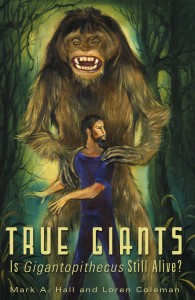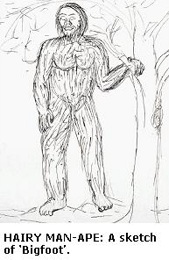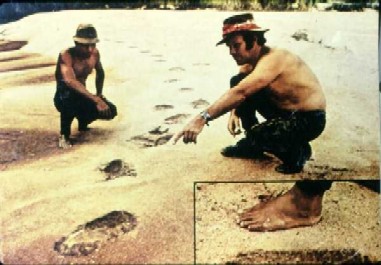Orang Dalam = True Giants
Posted by: Loren Coleman on November 30th, 2010

True Giants: Is Gigantopithecus Still Alive?
Hairy jungle giants in Malaysia have a long tradition of encounters with local peoples.
On the 6th of August of 1966, the Associated Press and the Straits Times reported that tracks "measuring 18 inches and having a stride of 12 feet [sic] were discovered at a rubber estate near Segamat, a small town about 80 miles from" Kuala Lumpur. Villagers told newsmen they believe the prints were made by a giant ape.

Nine days later, the The Malay Mail said that that Segamat villagers were telling of a "shy, harmless, giant with 18-inch footprints living in the jungle, possibly under pressure from advancing civilization and loss of feeding grounds" that was 25 feet tall.
I have other Malaysian reports from 1954 (AP, 3 Jan 1954), 1969 (UPI, 7 Aug 1969), and 1971 (AP, 1 Aug 1971) of "giant ape" sightings and expeditions.

Harold Stephens article ("’Abominable Snowman’ of Malaysia," Argosy, August, 1971) on Orang Dalam encompasses the sense of these animals from 1871, 1953 and 1959, until his find of the large footprints on the lower Endau River. Most of the accounts are of extremely large hominoids. Ivan T. Sanderson and Mark A. Hall, of course, both mention them too.
Hall and my new book True Giants: Is Gigantopithecus Still Alive? discusses them as part of the True Giants traditions gathered extensively for years. Indeed, the cover is about one such sighting, and the opening of the book details the incident.

About Loren Coleman
Loren Coleman is one of the world’s leading cryptozoologists, some say “the” leading living cryptozoologist. Certainly, he is acknowledged as the current living American researcher and writer who has most popularized cryptozoology in the late 20th and early 21st centuries.
Starting his fieldwork and investigations in 1960, after traveling and trekking extensively in pursuit of cryptozoological mysteries, Coleman began writing to share his experiences in 1969. An honorary member of Ivan T. Sanderson’s Society for the Investigation of the Unexplained in the 1970s, Coleman has been bestowed with similar honorary memberships of the North Idaho College Cryptozoology Club in 1983, and in subsequent years, that of the British Columbia Scientific Cryptozoology Club, CryptoSafari International, and other international organizations. He was also a Life Member and Benefactor of the International Society of Cryptozoology (now-defunct).
Loren Coleman’s daily blog, as a member of the Cryptomundo Team, served as an ongoing avenue of communication for the ever-growing body of cryptozoo news from 2005 through 2013. He returned as an infrequent contributor beginning Halloween week of 2015.
Coleman is the founder in 2003, and current director of the International Cryptozoology Museum in Portland, Maine.










Wouldn’t 18 inches be insufficient for the feet of a 25′ giant?
Well, it depends on what exactly the 18 inches is measuring, now doesn’t it? As Mark A. Hall says, a track is not a foot.
25? If they still exist with that height, then I must say this is the real king kong. Who cares about Bigfoot’s nickname as “King Kong”. The orang dalam takes the name.
Ok, fair enough. However, since we’re talking about primates here (alleged primates at least, since we haven’t captured one yet), we can see there’s a certain consistent correlation between the length of the foot-print and the actual length of the foot. The plantar archs might disguise a bit the width of the foot, but would it be too preposterous to conclude that, with primates, what you see (tracks) is what you get (foot size)?
The reason I raise these issues, it’s because it occurs to me that a giant 25′-height ape living in such a humid environment (the jungle) would require a much larger set of feet as these tracks seem to indicate. Otherwise the poor fellow’s enormous weight would cause him to sink every time he tried to cross a muddy river stream! 😉
So maybe the estimate heights given by the witnesses are a bit off. But nevertheless —and this is something I’ve discussed in previous threads— the actual biomechanics of oversized creatures is something that interests me greatly.
PS: It also occurs to me that, if the height estimates are indeed accurate, that perhaps the size of the print would suggest these giant apes move most of the time walking on all fours, and only rarely do they would show biped mobility. With such an enormous size and weight, that would make more sense —and I guess that’s also the reason why modern renderings of Gigantopithecus show these fossil primates as quadrupeds most of the time.
Actually, Red_pill_junkie, most paintings and models of Gigantopithecus show a quadrupedal stance because they take gorillas and orang-utans, which usually move in a four footed (knucklewalking) stance, as their model. In fact, one of the most used responses I get whenever I speak to Bigfoot skeptics is that the big fellows can’t exist because only humans, among primates, have a full time bipedal gait. Then, if I mention anything about True Giants, I’m hit with the statement that a bipedal body stance that large is impossible; not enough cross-section in the hips and legs to support that large a body. This can be a bit of a problem until you realize that, while maintaining a much less efficient body stance, Tyrannosaurus did just fine, being a biped, and gravity just hasn’t changed since then. Life will find a way.
Those are very interesting comments, graybear.
Yes, carnivore dinosaurs (theropods) were bipeds, but I believe we shouldn’t miss the fact that they had a tail to help them balance their weight. Not only that, but the link between dinosaurs and birds also means those fearsome giants had hollow bones.
I’m really interested in the use of new technologies in order to investigate the dynamic capabilities of extinct creatures. Like probably all fans of Cryptozoology, I was amazed with the velocity of the T. Rex shown by Spielberg in Jurassic Park. Later I we were told that T. Rexes were nowhere near to moving that fast in real life, only to be old more recently that perhaps they did manage to make the occasional sprint when hunting their preys –although obviously a 4X4 Jeep was not among them 😉
Perhaps someone will decide in the future to apply those same computer modeling techniques to deduct more about Gigantopithecus, although they will remain highly speculative guesses, since we don’t have a complete skeleton.
Red_pill_junkie; yes, the theropod dinosaurs did have tails to help with their balance, but that long, thick, muscular tail also added a lot of weight for the legs and hips to carry. Weights of five to seven and even nine tons have been attributed to T. Rex, and it all had to be carried on those two massive legs. That was the actual point of my previous post; no one is saying that the True Giants are anywhere near that weight, therefore if theropod dinosaurs achieved the height and weight they did, then it is not impossible for primates, which would have been far lighter than the dinos, to achieve a similar height.
If we had more fossils of Gigantopithecus (something that wouldn’t fit in a shoe box, for example), and particularly a piece of hip or leg (mostly we have some teeth and some partial mandibles–hard to tell much about the feet from a tooth), then we could say definitively how their locomotion works(ed). Until then, just watch the CGI Kong (please do ignore the story) and hope for more bones of the big one.
Graybear, I think we can agree that on more than one occasion, when experts have determined something about what Nature “can” or “cannot” accomplish, Nature has always been delighted to prove them wrong —again and again 😉
So yeah. Even though we cannot know for certain about the physical prowess of those big-ass primates —or if there could actually be even bigger ones— I hereby invite any paleontology undergraduate, with a knack for computers and CGI, to toy around with a digital model of a Gigantopithecus skeleton, and see what that reveals.
Man I really hope a full skeleton of Giganto is found in the future. I bet it’d stir even more controversy than the Flores fossil 🙂
25 feet tall is too much for me to accept without some pretty serious proof.
Human-type bipedalism places a lot of strain on the back and requires pretty serious changes to the pelvis. Think, for example, of the back problems pregnant women often have. These problems would be exaggerated for a really large creature. They could perhaps be overcome, but — as always — at a cost. That begs the question: What evolutionary advantage would such a large size carry? Protection from predators? Access to new food sources? Neither of these seems very likely.
Absolutely! And wouldn’t it be fun if someone did find a full or nearly full Giganto skeleton? Judging from the brou-ha-ha over the Flores finds, a third of the anthropologists would call it the find of the century, a third would call it an ancient case of acromegaly, and a third would say that its a diseased whale.
Loren Coleman responds:
November 30th, 2010 at 12:56 pm
“Well, it depends on what exactly the 18 inches is measuring, now doesn’t it? As Mark A. Hall says, a track is not a foot.”
What on earth is that supposed to mean? Your own source you quote above has the word footprint in it. What exactly are you trying to suggest with this mysterious answer? Did this 25-foot ape supposedly have hooves?
I believe loopstheloop is writing from Spain. I apologize if my sense of humor is lost in translation. Some folks would have read my remark and understood on one level the smile & chuckle I was trying to convey. Never mind; a joke explained is a sunrise not appreciated.
More importantly, of course, I was not talking about hooves but the fact that something that measures 18 inches in the ground (a track) does not mean that the foot was only 18 inches long. It could be a partial print, a situation in which the placing of the foot is only partially captured in the surface recording the evidence. That, quite simply, is the essence of the serious part of my meaning.
Back to being dead-pan for a moment: are you suggesting that a 25-foot giant tip-toed across this surface in order not to be spotted? You’d have to say such a creature would have as much chance of going unnoticed as one of your brilliant saucy jokes! (Seriously, though… is that you inference here?)